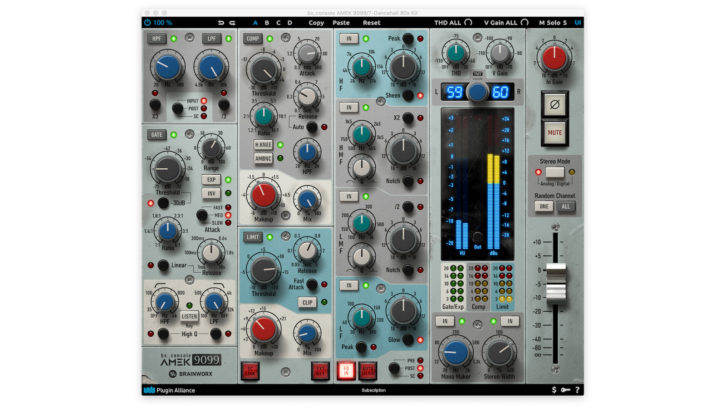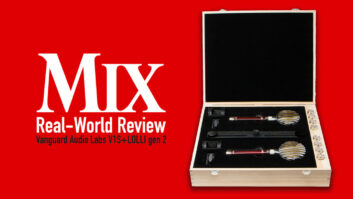
 This was Mix’s 20th most-read article of 2022!
This was Mix’s 20th most-read article of 2022!
The Tolerance Modeling Technology developed by Brainworx is much more than a marketing term. It’s a powerful and effective system for creating realistic software console emulations.
With TMT, Brainworx (and its partner, Plugin Alliance) builds its modeled components with the same tolerances as their hardware counterparts. That gives the console similar channel-to-channel variations as would be found in the hardware. Brainworx TMT plug-ins can have up to 72 independent channels, and none are exact copies of each other.
Brainworx has already released models of SSL, Neve and Focusrite desks, and its latest product is an emulation of the AMEK 9098i, a legendary console built by the late Rupert Neve. Not only does the plug-in replicate that console’s circuitry, it also adds plenty of useful “digital only” features. According to Brainworx, the AMEK 9099 has the deepest feature set of any of the company’s TMT channel strips. As you would expect from Brainworx, the plug-in is well designed. You can resize the GUI from 50% to 150%— a useful option—while in addition to a global Mute button, every major component can be switched on and off, even the individual EQ bands.
UP THE SLOPE
The signal chain begins with the input preamp and highpass and lowpass filters. The HPF defaults to a range of 20 Hz to 300 Hz, but you can press the x3 button to shift it up to 60 Hz to 900 Hz. The LPF defaults to 4.5 kHz to 30 kHz. It has a “/3” (divided by 3) button that lowers it to 1.5 kHz to 10 kHz. Both filters roll off at a healthy 18 dB per octave slope. The switchable ranges provide more filtering flexibility and were not on the 9098i. You can also switch the placement of the filter section in the signal chain from after the input to after the Gate and Compressor, or in the dynamics sidechain.
The Gate section offers both Gate and Expander modes. The latter features an over-easy response. Pressing the Invert button lets you hear only what the Gate is attenuating, which can be useful when adjusting it.
Other controls include Threshold and Range knobs. If you’re dealing with really low-level signals, you can press the Threshold Range button, which lowers the whole range by 30 dB. The Ratio knob is for Expander Ratio and Gate Hold, depending on which mode you’re in. Expander mode governs the attenuation ratio; Gate mode controls the time it takes for the gate to close after the signal drops below the threshold.
The Gate Release control works the same in both modes, controlling the speed of attenuation. For the attack speed, you get three buttons: Fast, Medium and Slow. Finally, the Linear button toggles between the default linear release curve and the alternate, exponential one.
The Gate section also offers an HPF with a Q control and an LPF that functions as a sidechain. The Key Listen button lets you hear the sidechain input signal soloed. I found the Gate/Expander to be both deep and flexible. I was able to dial in natural-sounding settings for reducing drum bleed, guitar buzz and more.
SQUEEZE AND LIMIT
The Compressor section, which emulates the hybrid digital-and-VCA Compressor in the 9098i, offers plenty of options, including the standard Threshold, Ratio, Attack and Release knobs, plus a button that turns on the handy Auto-Release feature. A Makeup Gain knob is available, as well. With the press of a button, you can toggle the Compressor between hard- and soft-knee operation.
I was initially puzzled by a button labeled AMBNC, which stands for Ambience. When activated, it changes the Compressor’s output to the difference between the compressed audio and the input signal. When there’s no gain reduction, you won’t hear anything with AMBNC on. The manual promises that the AMBNC lets you hear better what the Compressor is doing, but, for me at least, it was more confusing than helpful. That said, you can use it as an effect to create sounds that differ from either the compressed or uncompressed signal.
Brainworx also added two “plug-in-only” features to the Compressor section—a Mix knob for dialing in parallel compression and a dedicated High-Pass Filter situated at the beginning of the Compressor’s sidechain.
The AMBNC control notwithstanding, I found the Compressor section to be excellent for dynamics control. Its tone is quite transparent, which is either a plus or minus, depending on what you’re trying to do. I was hoping it would have a little more of a “sound” to it.
Fortunately, if you want character, the Limiter, which is separate from the Compressor and a mix of 9098i features and plug-in-only additions, has plenty to offer. The original features include the Threshold and Release knobs and a Fast Attack button. One of the plug-in-only features is a Makeup Gain knob, which is handy considering the Limiter’s ability to squash the signal.
The Mix knob is also not from the original, but I’m glad Brainworx added it. Often, I got the best results by dialing in an extreme setting and then backing off the Mix knob, making the limiting parallel.
The Clip button was also added. When you press it, the Release Time knob disappears, and both the attack and release times become extremely fast. The result is a saturated sound that you can further intensify by pressing the Fast Attack button. I definitely liked the Limiter and found ways to use it on almost every channel.
TWEAKING THE TIMBER

The EQ section is mainly true to the 9098i, although Brainworx made it more versatile for frequency selection. It offers four bands: High-Frequency, High-Mid Frequency, Low- Mid Frequency and Low-Frequency. Being able to switch each band on and off was handy for checking their effect on the sound as you go. The HF is semi-parametric with a knob for frequency selection (2 kHz to 21 kHz). You can switch it between a high-shelving filter and a peak filter. A button called Sheen switches either filter to a more gradual curve.
The HMF is fully parametric, with Gain (±18 dB), Frequency (500 Hz to 4.5 kHz) and Q knobs. The HMF x2 button, which wasn’t on the 9098i, changes the frequency range for the band to double the original, moving it to 1 kHz to 9 kHz, which significantly overlaps the HF. If you want to apply a more surgical boost or cut, the HMF x2 button is handy.
Speaking of surgical, you can press a button and switch the HMF filter from Peak to Notch, which is unusual for a channel strip but a nice capability to have in your back pocket.
Other than its frequency range, the LMF band is a lot like the HMF. It has all the same controls except that instead of a x2 button, it has one labeled “/2” (divided by two). Pressing it switches the LMF range from 100 Hz to 1 kHz to 50 Hz to 500 Hz. It is also similar in architecture to the HF, with a range of 30 Hz to 300 Hz, and you can switch the filter from low-shelving to peak. A Glow button, rather than Sheen, softens the filters.
An EQ In switch globally bypasses all the bands and a Routing button lets you choose where in the signal chain the EQ will reside. Finally, you get an Auto Listen button that solos the section where you made your most recent adjustment of frequency or Q. Without question, the EQ section is more complex than is typical on a channel strip, but it’s quite powerful and flexible.
THE WAY OUT
The Master section of the AMEK 9099 is fully stocked, starting with a nice-sized meter section that offers both a VU and a Peak version that reads out in dBu. You can switch them to show input or output. Right below are five-step LED ladder meters for the Gate, Compressor and Limiter.
Two knobs with on/off switches—Mono Maker and Stereo Width—sit at the bottom of stereo channels. Mono Maker is useful because any signal below the frequency you set gets folded into mono. That allows you to, for example, tighten up the stereo image of a track in the sub 200 Hz range (which sound more focused in mono anyway) while leaving the higher frequencies intact. Stereo Width is excellent for widening tracks without making them lose punch. It stays natural-sounding until you get above about two-thirds of the knob’s range.
Other controls include Phase (polarity) invert and the global Mute button. You also get several features specific to the TMT emulation, including the THD knob, which lets you add harmonic distortion to the channel. You can also add extremely subtle noise to the signal for increasing the analog simulation by turning up the V (virtual) Gain knob.
Also in the Master section are buttons that let you randomize which of the 72 available virtual channels you’re using on a given instance of the plug-in. You can randomize a particular channel with the One button, or every instance in your session with the All button.
On the far right, where it says Stereo Mode, you have two choices: Analog means that all stereo channels will have different channels assigned to their left and right sides. Digital means that stereo channels will have the same virtual channel assigned to them.
All of the TMT features are subtle, particularly when you’re dealing with one channel. But by using instances of AMEK 9099 on all mixer channels, you get a consistent sound reminiscent of a mixing desk.
CONSOLE YOURSELF
The AMEK 9099 gives you what you need to sculpt and mix in any genre. If you want clean, it gives you that. If you want vibey, it can do that, too. Some of its features are relatively complex, but its essential functions are intuitive enough, even for a novice. It’s the kind of plug-in that you can grow into. The more you use it, the more you’ll get from it. Overall, it’s highly impressive.
It is somewhat pricey, but Plugin Alliance runs plenty of sales if you’re patient. If you want it right away but don’t want to spring for the full price, it’s included in several of the Plugin Alliance subscription bundles, which allow you to get your hands on a huge range of plug-ins for a low monthly fee.







